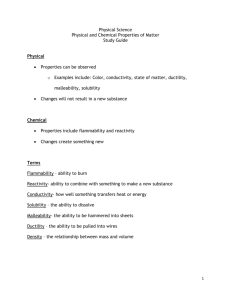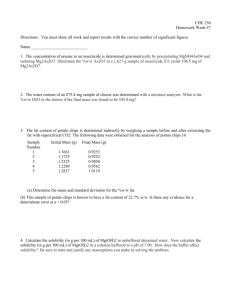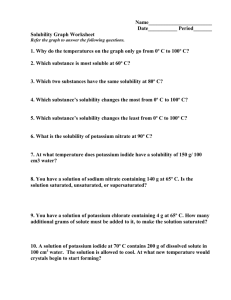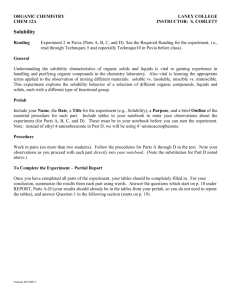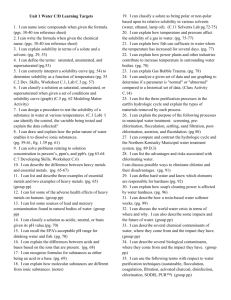Unit Plan Grade 11 Chemistry: Solutions and Solubility Avital
advertisement
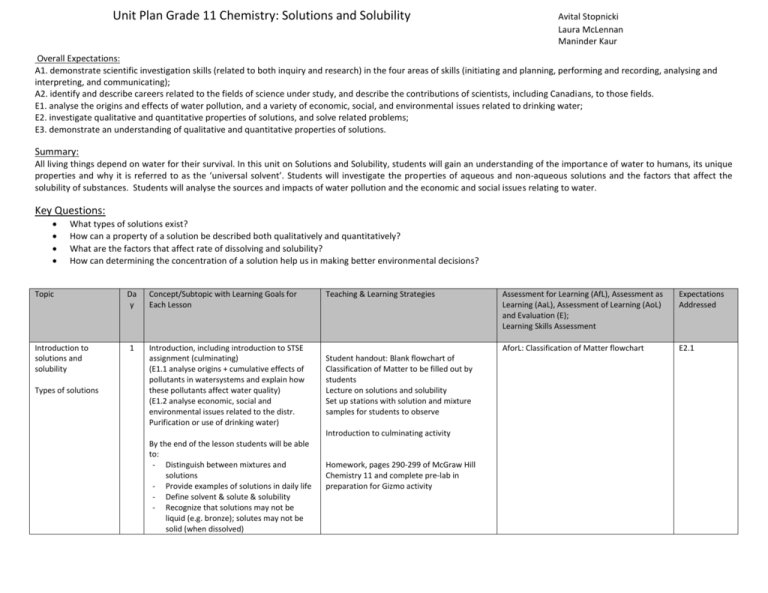
Unit Plan Grade 11 Chemistry: Solutions and Solubility Avital Stopnicki Laura McLennan Maninder Kaur Overall Expectations: A1. demonstrate scientific investigation skills (related to both inquiry and research) in the four areas of skills (initiating and planning, performing and recording, analysing and interpreting, and communicating); A2. identify and describe careers related to the fields of science under study, and describe the contributions of scientists, including Canadians, to those fields. E1. analyse the origins and effects of water pollution, and a variety of economic, social, and environmental issues related to drinking water; E2. investigate qualitative and quantitative properties of solutions, and solve related problems; E3. demonstrate an understanding of qualitative and quantitative properties of solutions. Summary: All living things depend on water for their survival. In this unit on Solutions and Solubility, students will gain an understanding of the importance of water to humans, its unique properties and why it is referred to as the ‘universal solvent’. Students will investigate the properties of aqueous and non-aqueous solutions and the factors that affect the solubility of substances. Students will analyse the sources and impacts of water pollution and the economic and social issues relating to water. Key Questions: What types of solutions exist? How can a property of a solution be described both qualitatively and quantitatively? What are the factors that affect rate of dissolving and solubility? How can determining the concentration of a solution help us in making better environmental decisions? Topic Da y Concept/Subtopic with Learning Goals for Each Lesson Introduction to solutions and solubility 1 Introduction, including introduction to STSE assignment (culminating) (E1.1 analyse origins + cumulative effects of pollutants in watersystems and explain how these pollutants affect water quality) (E1.2 analyse economic, social and environmental issues related to the distr. Purification or use of drinking water) Types of solutions Teaching & Learning Strategies Student handout: Blank flowchart of Classification of Matter to be filled out by students Lecture on solutions and solubility Set up stations with solution and mixture samples for students to observe Introduction to culminating activity By the end of the lesson students will be able to: - Distinguish between mixtures and solutions - Provide examples of solutions in daily life - Define solvent & solute & solubility - Recognize that solutions may not be liquid (e.g. bronze); solutes may not be solid (when dissolved) Homework, pages 290-299 of McGraw Hill Chemistry 11 and complete pre-lab in preparation for Gizmo activity Assessment for Learning (AfL), Assessment as Learning (AaL), Assessment of Learning (AoL) and Evaluation (E); Learning Skills Assessment Expectations Addressed AforL: Classification of Matter flowchart E2.1 Unit Plan Grade 11 Chemistry: Solutions and Solubility Avital Stopnicki Laura McLennan Maninder Kaur Topic Da y Concept/Subtopic with Learning Goals for Each Lesson Teaching & Learning Strategies Assessment for Learning (AfL), Assessment as Learning (AaL), Assessment of Learning (AoL) and Evaluation (E); Learning Skills Assessment Expectations Addressed Factors that affect rate of dissolving and solubility Plotting solubility curves 2 Temperature & Solubility Solubility Curves Whole Class learning - take up of Gizmo Warm Up Activity from homework. In pairs students complete Activity A (15 mins) AofL: student responses during class discussion (anecdotal notes) E2.1 E2.2 E3.3 Factors that affect rate of solubility, continued 3 By the end of the lesson students will know: how temperature affects solubility, how to analyse and interpret solubility curves, communicate and understand terminology related to chapter 4 Concentration of solutions m/m, m/v, v/v, molar Discussion and interpretation of solubility curves Additional factors affecting solubility (Pressure, agitation, particle size, polarity, surface area) By the end of the lesson students will be able to interpret and analyze a solubility curve, and describe factors affecting solubility Problem Solving m/m m/v v/v By the end of the lesson students will be able to solve concentration problems. continued 5 Questions & Concerns on: Concentration Problem solving Molarity By the end of this lesson students will be able to: calculate concentrations of solutions and demonstrate an understanding of Molarity. E: Activity B (marking scheme) [KU, TI, A, C] Gizmo activity B completed in class to be prepared for handing in next class Gizmo available at: http://www.explorelearning.com/index.cfm? method= cResource.dspDetail&ResourceID=384 Lecture Discussion with PowerPoint or SMARTboard Video and in-class demonstration of other factors (e.g. bottle of clubsoda, video: http://www.youtube.com/watch?v=4cr9w23G cTs “Factor Affecting Solubility”) A for L – student responses during class discussion E2.2 E3.3 Real life examples and discussion on concentrations of solutions (e.g. vinegar, fruit crystal drinks, rubbing alcohol) Modeled solving of concentration problems – gradual release to problem solving in small group /pairs on worksheet/textbook problems A for L: Observations of student work, student responses during guided examples (anecdotal notes) E2.2 E2.6 Assignment handout: Solubility curve with concentration problems – to be evaluated Question and Answers; take up concentration questions Guided lesson (using PowerPoint/SMARTboard) on moles and molarity Assigned questions on molarity E: Solubility curve assignment (marking scheme) [A, TI] A as L: Peer and self-evaluation of answers A of L: observation and conversation during problem solving (anecdotal notes/checklist) E2.2 E2.6 Unit Plan Grade 11 Chemistry: Solutions and Solubility Avital Stopnicki Laura McLennan Maninder Kaur Topic Da y Concept/Subtopic with Learning Goals for Each Lesson Teaching & Learning Strategies Assessment for Learning (AfL), Assessment as Learning (AaL), Assessment of Learning (AoL) and Evaluation (E); Learning Skills Assessment Expectations Addressed Determining concentration of a solution 6 Quiz on Concentration Problems – 10 mins Preparing solutions Demonstration for use of equipment Review of safety in lab Lab – small group completion of experiment A of L and E – quiz E2.3 E2.2 By the end of this lesson students will be able to: Prepare sol’ns of a given concentration Dilute a concentrated sol’n Dissolve a solute in a solvent Aqueous Solutions and Water Quality 7 The importance of water (the universal solvent) Video for properties of water: http://www.youtube.com/watch?v=EKHTI2EN IMg&feature=player_detailpage Properties of water (review) Concentration of substances in water Sources compromising quality of water Checklist for: concentration calculations, lab safety, proper use of equipment Homework: Student to read assigned article in preparation of jigsaw activity Literacy and vocabulary exercise A for L – observation of discussions (anecdotal notes / checklist) E2.8 E3.1 A for L: observation during investigation (checklist of lab skills) A of L: investigation Questions for [KU] and [C] E3.2 Video from the Canadian Nature Museum: http://www.youtube.com/user/ canadanaturemuseum/videos Jigsaw activity using variety of articles on water quality & water pollution By the end of the lesson students will be able to identify sources of contamination and pollution in water sources and suggest ways to improve water quality (ties into culminating activity) Making Predictions about Solubility 8 Factors that affect the solubility of Ionic Substances Solubility guidelines Perform qualitative analysis of ions in solutions By the end of the lesson, students will be able to summarize the rules for solubility of ionic compounds. Solubility Rules investigation – see handout Assignment: compose a song/rap, make a powerpoint presentation, create a YouTube video, prepare a brochure, etc. which summarizes the solubility rules. E: Solubility Rules Assignment (rubric) Unit Plan Grade 11 Chemistry: Solutions and Solubility Avital Stopnicki Laura McLennan Maninder Kaur Topic Da y Concept/Subtopic with Learning Goals for Each Lesson Teaching & Learning Strategies Assessment for Learning (AfL), Assessment as Learning (AaL), Assessment of Learning (AoL) and Evaluation (E); Learning Skills Assessment Expectations Addressed Reactions in Aqueous Solutions 9 Reactions - Describe combinations of aqueous solutions that result in the formation of precipitate or a gas Demonstrations of reactions in aqueous solutions – eg. Alka-seltzer in water to produce gas; colour change, precipitates. A for L: observation of student responses during demonstrations and discussion. (anecdotal notes); exit ticket. E3.4 By the end of the lesson, students will be able to identify the formation of precipitates in aqueous solutions Introduction to Stoichiometry Smartboard/PowerPoint lesson on Reactions in Aqueous Solutions A for L: observation during class discussion (anecdotal notes) E2.5 E2.6 A as L, A for L: gallery walk of student solutions. : E2.6 Stoichiometry in solution chemistry 10 By the end of the lesson, students will be able to solve stoichiometry problems. Anticipatory Set: Demonstration – the Oscillating Clock (see http://www.chem.fsu.edu/outreach/ Oscillating%20Clock.pdf) In Class worksheets on previous lesson (pairs, small groups) Stoichiometry in solution Chemistry 11 Stoichiomety, con’t Guided lesson stoichiometry problems GalleryWalk – solve problem in pairs and small groups – gallery walk of solutions Stoichiometry problem solving Work Period on Culminating Activity 12 By the end of the lesson, students will be able to solve stoichiometry problems. Work Period on Culminating Activity (no new learning goals) Introduction to Acids & Bases 13 What is an acid? What is a base? Examples of acids and bases Properties of Acid and Bases (Electrical conduction, Litmus test, taste, feel, reaction with metals, reaction with carbonate) By the end of the lesson students will be able to explain the difference between an acid and a base, and identify properties of acids and bases. (Based on observations, consider doing more guided solutions to problems) Library / computer period for research Small group presentations to students by librarian on research methods and sources Demonstration of examples of everyday acids and bases (e.g. lemon juice, soap, stomach acid) Interactive SMARTboard lesson on Acids & Bases, including whole class discussion of acids and bases A for L: interviews with students on planning and progress E1.1 E1.2 E2.8 E2.1 AforL: observation during whole class discussion / anecdotal notes; exit ticket on acids & bases Unit Plan Grade 11 Chemistry: Solutions and Solubility Avital Stopnicki Laura McLennan Maninder Kaur Topic Da y Concept/Subtopic with Learning Goals for Each Lesson Teaching & Learning Strategies Assessment for Learning (AfL), Assessment as Learning (AaL), Assessment of Learning (AoL) and Evaluation (E); Learning Skills Assessment Expectations Addressed Theories of Acids & Bases 14 Arrhenius Theory Acids produce H+ ions Bases produce OH- ions (hydroxide ions) Limitations of the theory Discrepant Event: Water into Wine into Milk (University of Manitoba: http://bit.ly/Ow28qP) A for L: note and T-chart E3.5 E2.1 Bronsted Lowry Theory of Acids & Bases Acid is substance from which H+ (proton) can be removed Bases can remove a H+ from a substance A as L: Students to compare T-charts with seat partner(s) and revise as necessary Interactive Powerpoint/SMARTboard presentation on theories By the end of the lesson, students will be able to: 1. Complete a summary note explaining the two theories of acids & bases 2. complete a T-chart which summarizes the differences between the two theories Strong & Weak Concentration of Acids and Bases Titration Titration – con`t 15 16 Strong and weak acids Strong and weak bases pH (concentration of ions in water) By the end of the lesson, students will be able to: Explain the difference between strong and weak acids and bases in terms of degree of ionization Acid-Base Reactions -titration By the end of the lesson, students will be able to: -Determine the concentration of an acid and base in solution using titration; -use appropriate terminology related to titration -assemble and use titration equipment 17 Titration Laboratory By the end of the lesson, students will be able to determine the concentration of an acid and base in solution using titration Students to, in small groups, rotate through stations for investigation of: Strong and weak acids Strong and weak bases pH indicators and complete an observation chart A for L,: Observation and conversation as students rotate through stations (anecdotal notes) E3.6 E2.2 E2.3 E2.1 Teacher led GIZMO on titration (www.explorelearning.com) A for L: GIZMO Exploration Sheet E2.5 E2.7 E2.1 A for L: pre-lab 2.7 2.1 2.2 3.5 A of L: observation of scientific inquiry skills (checklist) Teacher demonstration of titration equipment, including indicators Homework: pages 399-403, prepare titration pre-lab & observation chart Titration Laboratory E: lab report and related questions [C, T/I, K/U, A] Unit Plan Grade 11 Chemistry: Solutions and Solubility Avital Stopnicki Laura McLennan Maninder Kaur Topic Da y Concept/Subtopic with Learning Goals for Each Lesson Teaching & Learning Strategies Assessment for Learning (AfL), Assessment as Learning (AaL), Assessment of Learning (AoL) and Evaluation (E); Learning Skills Assessment Expectations Addressed Culminating Activity 18, 19 Culminating Activity Work Periods Student Presentations on culminating activity AasL: Peer and Self Evaluation of Culminating Activity Review: Q&A scramble E: rubric for culminating activity Unit Test E: unit test [C, T/I, K/U, A] 1.1 1.2 2.1 2.2 2.5 2.8 3.1 3.2 3.3 2.1 2.3 2.5 2.6 3.1 3.3 3.4 3.5 3.6 Unit Review (no new learning goals) Unit Test 20 Unit Test (no new learning goals) Accommodations for exceptional students and English Language Learners: Students identified as exceptional will be provided with accommodations and modifications as set out in their Individual Education Plans. Such accommodations may include strategic seating, strategic grouping, extra time for completion of assignments, and assistive technology. Assignments have been designed to provide choices to students as to how they wish to complete the assignment (e.g. compose a song, or prepare a multi-media presentation). Lessons are designed to incorporate visual and graphic elements in addition to written materials. Vocabulary sheets (glossaries) may be provided to ELLs and students who would benefit. All students are encouraged to use multiple strategies (writing, diagrams, maps) to learn concepts. Resources: 1. McGraw Hill Ryerson –Chemistry Text book Course code SCH3U Unit Plan Grade 11 Chemistry: Solutions and Solubility Avital Stopnicki Laura McLennan Maninder Kaur



